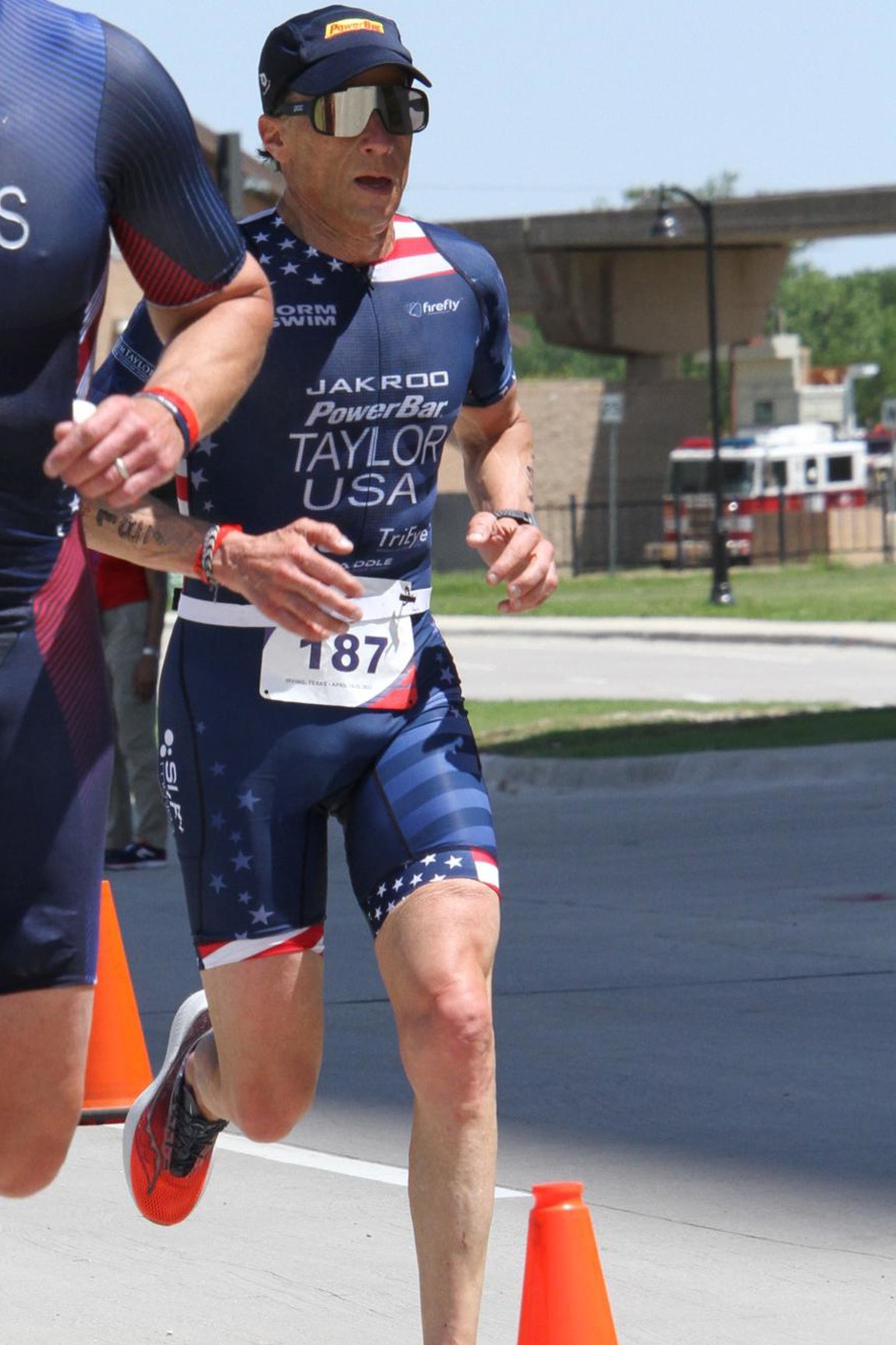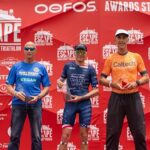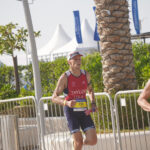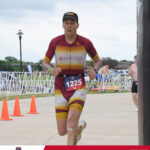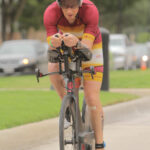Last month, I was fortunate enough to receive a free entry into the iconic Escape from Alcatraz triathlon to be held on June 11th. I accepted the entry with a sense of both excitement and a bit of trepidation. I’ve done Alcatraz four times before, but the last time was in 2008, just before I began my 11-year hiatus from our sport. I have avoided the race since 2019, when I re-entered triathlon, because the registration cost is insanely high.
before I began my 11-year hiatus from our sport. I have avoided the race since 2019, when I re-entered triathlon, because the registration cost is insanely high.
Alcatraz is unique in many ways including its irregular distances (swim: 1.5 miles, bike: 18 miles, run: 8 miles) and route through San Francisco. But what makes it so demanding is the nature of the three courses. In most triathlons, it’s not uncommon to have one demanding leg of the race that is challenging and sometimes two out of three are tough. But what makes Alcatraz truly daunting is that all three legs of the race are exceptionally demanding.
Race day usually starts off on a bad foot even before the race begins with cold air temperatures, fog, potentially wet roads, and a strong westerly wind. The race in 2022 was held during heavy rain; talk about adding insult to injury.
Perhaps the most notable part of the race is the swim, which requires competitors to jump off a perfectly good boat into the middle of San Francisco and battle cold temperatures (around 55 degrees), rough water (white caps some years), strong currents (people have gotten  caught in its westward pull toward the Golden Gate Bridge) and tricky sighting and navigation to the swim exit (you can’t swim directly, but rather have to cross the current and then ride it along the shore).
caught in its westward pull toward the Golden Gate Bridge) and tricky sighting and navigation to the swim exit (you can’t swim directly, but rather have to cross the current and then ride it along the shore).
The bike leg is no ride in the park either (actually it is because part of the course goes around Golden Gate Park). It has six significant climbs with 1600 feet of elevation gain, sharply curving descents, strong head and cross winds coming off the ocean, and a lot of rough road surfaces with plenty of pot holes, cracks, and speed humps.
Even after all that adversity, it’s not over because the run has its own set of challenges. It begins with what is usually a steady headwind on the 1.6-mile flat stretch to the base of the Golden Gate Bridge (GGB). It continues with a long climb out of Chrissy Field up to the Golden Gate Bridge and beyond. The climb includes a steep ascent up well-spaced wood-beam steps that are definitely leg burning. After reaching the apex of the run, the course narrows to a very uneven dirt and sand trail that descends down to Baker Beach. Once there, you begin your return by slogging through heavy sand to the water’s edge (harder surface) to the base of the notorious Sand Ladder. It is an incredibly steep and sandy climb back out from the beach with round posts for steps that is both lung and leg busting (it’s around 360 steps depending on your stride). From there, it’s a fairly manageable climb to the course’s apex, a descent to Chrissy Field, and then that 1.6-mile race to the finish
the apex of the run, the course narrows to a very uneven dirt and sand trail that descends down to Baker Beach. Once there, you begin your return by slogging through heavy sand to the water’s edge (harder surface) to the base of the notorious Sand Ladder. It is an incredibly steep and sandy climb back out from the beach with round posts for steps that is both lung and leg busting (it’s around 360 steps depending on your stride). From there, it’s a fairly manageable climb to the course’s apex, a descent to Chrissy Field, and then that 1.6-mile race to the finish
I have to admit that I prefer racing under “classic” triathlon conditions, meaning warm and flat water (preferably a lake), a flat and straight bike course (where I can stay in aero position most of the ride), and a flat and smooth run course (where I can charge from start to finish). So, despite my excitement about being able to race in Alcatraz again, I was definitely feeling intimidated by the multiple challenges that I would be face with and realized I needed to prepare mentally as much as I would be preparing physically for the race. In other words, I had to “practice what I preach!”
Knowledge is Power
There are three things that we humans really don’t like: unfamiliarity, unpredictability, and lack of control (it’s an evolutionary thing). And Alcatraz had those in spades! The way to combat those three enemies is by following my adage: Knowledge is power.
 So, with five weeks until the race, my first goal was to learn as much as I could about the swim, bike, and run courses. Thankfully, I live only about 15 minutes from the course, so I had ready access to it. I started off by reading the Alcatraz website and studying the course maps. I also found some really valuable YouTube videos about each course that offered me both insights and helpful tips for navigating the courses.
So, with five weeks until the race, my first goal was to learn as much as I could about the swim, bike, and run courses. Thankfully, I live only about 15 minutes from the course, so I had ready access to it. I started off by reading the Alcatraz website and studying the course maps. I also found some really valuable YouTube videos about each course that offered me both insights and helpful tips for navigating the courses.
Course Recon
The most valuable part of my preparations has been to actually swim, bike, and run the courses multiple times. First, no one can actually do the swim course, but I got accustomed to swimming open water in the cold Bay temperatures with the currents in Aquatic Park, a semi-enclosed area that is a popular swim site for triathletes. I have been able to get four swims up to 2000 yards in with one more weekend opportunity ahead. As someone who swam in Aquatic Park upward of 30 times after Covid hit and pools closed, I can assure you that there is absolutely no joy in it, but it is a real confidence builder in preparation for the much more demanding swim from Alcatraz through San Francisco Bay.
opportunity ahead. As someone who swam in Aquatic Park upward of 30 times after Covid hit and pools closed, I can assure you that there is absolutely no joy in it, but it is a real confidence builder in preparation for the much more demanding swim from Alcatraz through San Francisco Bay.
I’ve been able to ride the bike course six times already to build my endurance and climbing power, and my confidence. I now know the climbs, descents, and road conditions well and feel confident in my fitness for meeting those demands. Of particular note are the climbs out of Ocean Beach, that is about .8 miles long with a last spike of more than 20% grade, and the last climb before descending to Chrissy Field that is about .6 miles long with an average gradient of around 10%.
One of the biggest challenges I’ve faced with the bike course is choosing either my triathlon bike or my road bike for the race. My road bike (an S-Works Venge) is lightweight, geared for climbing, agile, and comfortable to ride, but obviously not aerodynamic. In turn, my tri-bike (a Ceepo Shadow) is aero, but not well suited for climbing (or so I thought) with a 1x drivetrain setup with a 49t in front and a 10-33t in back  and not very agile for the descents. To help me decide, two of the six rides I took on the bike course were back-to-back, one lap on my tri-bike and one lap on my road bike. Much to my surprise, I found climbing on my tri-bike very doable and the aero benefits substantial, and I was several minutes faster compared to my road bike.
and not very agile for the descents. To help me decide, two of the six rides I took on the bike course were back-to-back, one lap on my tri-bike and one lap on my road bike. Much to my surprise, I found climbing on my tri-bike very doable and the aero benefits substantial, and I was several minutes faster compared to my road bike.
I also had the opportunity to do the run course five times. I was able to figure out how to pace (don’t go out too fast too early), when to push (on the flats at the start and end of the run), and when to just go steady (on the climbs and in the sand). I was also able to run the Sand Ladder and decide whether to walk it (as most competitors do) or run it (which, having lived nearby for several years back in the 2000s, was a regular route for me and a point of pride having done so in my four previous Alcatraz races). These practice runs gave me the confidence that I had the fitness to run a strong leg and not get crushed by the Sand Ladder.
Ladder and decide whether to walk it (as most competitors do) or run it (which, having lived nearby for several years back in the 2000s, was a regular route for me and a point of pride having done so in my four previous Alcatraz races). These practice runs gave me the confidence that I had the fitness to run a strong leg and not get crushed by the Sand Ladder.
Mental Imagery
Mental imagery was the final piece of the mental preparation puzzle, in which I have been spending five minutes a day imagining myself in key parts of the race, focusing on what I needed to do, what I wanted to think, and how I wanted to feel throughout the race. In a sense, with these mental rehearsals of the race, I am programming my mind for what I want to think, feel, and do on race day. The idea being is that,  during the race, I just run the program and trust my body to do what I’ve trained it to do. I place a particular emphasis on making my imagined experienced real and, by its very nature, hard. So, in my mind’s eye, I struggle with the currents during the swim, feel my lungs bursting on the climb on my bike out of Ocean Beach, and feel my legs on fire on the Sand Ladder. Importantly, I stay positive and motivated in my imagery, and see myself finishing strong on the final long flat to the finish line.
during the race, I just run the program and trust my body to do what I’ve trained it to do. I place a particular emphasis on making my imagined experienced real and, by its very nature, hard. So, in my mind’s eye, I struggle with the currents during the swim, feel my lungs bursting on the climb on my bike out of Ocean Beach, and feel my legs on fire on the Sand Ladder. Importantly, I stay positive and motivated in my imagery, and see myself finishing strong on the final long flat to the finish line.
In Sum
Escape from Alcatraz is an incredibly demanding triathlon. And that’s why we do it! By preparing myself mentally as much as I’ve prepared myself physically for the challenges on race day, I’m looking to be confident, motivated, fired up, and focused on race day, thus setting the stage for a great effort and, hopefully, a satisfying outcome.
stage for a great effort and, hopefully, a satisfying outcome.

